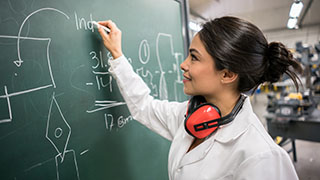Within the span of about five days in March, our nation’s school system moved from the unthinkable to the inevitable. To prevent the spread of the coronavirus, schools closed, and millions of students from kindergartners to high schoolers moved to a fully remote learning model. Now, as a new school year begins, districts are grappling with how to reopen, while remote learning has left students, especially the most vulnerable learners, even further behind.It’s a crisis for education, but it’s also an opportunity to put everything on the table and consider ideas that would have been impossible before COVID. Outdoor school, long relegated to the Waldorf fringe, is getting a serious look. The pandemic is forcing conversations about equity in education, and both parents and teachers are asking how we can reimagine the school day to prioritize student well-being and mental health.In other words, as schools adapt to COVID, what changes could actually transform education for the better?
Moving learning outdoors
COVID-19 is an airborne pathogen, meaning that one of the best ways to mitigate risk is to step outside into the open air. Yet, rather than move in-person school outdoors, districts have doubled down on virtual learning.
“On Monday of the week everything shut down, 100% distance learning seemed preposterous. By Friday, it was inevitable,” says Vanessa Carter, an environmental literacy content specialist at San Francisco Unified School District. “The pivot was, let’s get everyone in front of a screen. Is it any crazier to try to get kids 100% outside?”
(Carter notes that the ideas here are her own, and not meant to represent SFUSD decisions or current planning.)
Research shows that spending time in nature builds resilience and self-confidence in kids; reduces obesity and attention deficit disorder symptoms; and improves focus, behavior and learning. During the pandemic, it would also mean giving students in-person instruction rather than teaching via screens.
“Just to get kids back to in-person learning would be huge, for our youngest learners especially,” says Carter. “To start, use what you have. Move whiteboards and tables and chairs outside. Don’t reinvent the wheel.”
Carter acknowledges that there are challenges to taking learning outside. Not all schools have outdoor campuses or parks nearby, not all parks are created equal, and not all neighborhoods are walkable.
To make outdoor learning sustainable, schools would need infrastructure like tents and outdoor furniture, as well as more staff.
“Don’t leave it to schools to figure out how to pay for this,” says Carter. Could a government stimulus program support outdoor learning? Corporate sponsorships? With so much philanthropy being directed to COVID response right now, perhaps districts could appeal directly to environmental nonprofits and donors.
OPTIMISM METER
Hopeful: Given the renewed attention education has received in recent months, these potential fixes don’t feel as fictional as they once did.
And if outdoor learning starts by moving the classroom model into a yard or a park, it can grow beyond teaching regular curriculum in a new environment.
“We have this pretty remarkable workforce of environmental and outdoor educators and science educators in the Bay Area,” says Carter, pointing to staff members from children’s museums, science museums and organizations like the YMCA and NatureBridge who are cleared to work with children. “What if some of the funding to support education during COVID was routed through these organizations to redirect staff to schools, to support teachers with outdoor learning?”
Then the question becomes: How do we get kids outdoors? For schools near the Presidio, it’s easy; for campuses in the Tenderloin or Chinatown; it’s more challenging. Given that many tech companies have announced they will work from home for at least the next year, could there be a way to redeploy the fleet of tech buses that shuttles city dwellers to Silicon Valley? There are a mountain of obstacles to this — making sure buses are certified to transport kids, finding the funding to hire more drivers, especially since SFUSD just laid off all its bus drivers. But if this would allow in-person learning to take place, and potentially enable the district to rehire essential bus drivers, it’s a challenge worth tackling.
And when school finally goes back to “normal,” we should still think twice before herding kids back into the classroom all day.
“Being outside more I think you’ll see students are more calm and that there are tremendous mental health benefits,” says Carter, who also believes that truancy rates would decrease.
“We’ve tried the more, more, more approach,” she says of the conventional classroom. “It’s not working.”
That may be the strongest argument for a long-term shift to more outdoor learning — that it actually improves outcomes for kids. After the pandemic, let’s try to remember that.
Prioritizing student well-being

We won’t know the full mental health toll of the pandemic on children for years to come, but we do know this: As millions of families face financial hardship, the illness or loss of loved ones, prolonged uncertainty and the complete obliteration of normal routines, it’s a recipe for increased rates of anxiety and depression in kids and adolescents.
It’s also an opportunity for schools to rethink how they support students’ mental health.
Some schools are already doing this by building social-emotional learning (SEL) — lessons focused on how to manage and regulate emotions, build relationships and show empathy — into their curricula. But the pandemic is a chance to try bolder ideas. Especially since there is evidence that for some kids, getting a break from the pressure cooker of academic expectations and after-school commitments has been better for their mental health.
Even as we long to get back to “before,” it’s important to ask if before was really that great. We already had an epidemic of anxiety among children, teens and college students in the United States. This forced pause could be a time for educators and school administrators to reconsider how we support mental health at school.
Wendy Mogel, clinical psychologist and author of the parenting book “The Blessing of a Skinned Knee,” suggests an approach that is radical in its simplicity: Talk to the children. “If the question is, ‘How can we redesign the school day or focus on social-emotional learning to make kids less stressed?’ talk to them and see what they have to say.”
Mogel offers a set of questions that focus on student well-being: What do you miss most about school? What are you relieved about not having to do? What was the hardest part about the school shutdown, and what did you enjoy? What did you discover about the way you like to learn? “You need someone who is really good with kids — a youth pastor, the school psychologist — to ask the questions,” she says.
In Mogel’s experience, one of the biggest contributors to anxiety and stress in students is schools’ focus on conventional academic learning over creative intelligence, experiential learning and citizenship.
“Ideally, art, science and SEL would be woven into an integrated curriculum,” says Mogel. “And adding SEL to the Core Curriculum would give it both pride of place and legal standing.”
She also advocates for more time outdoors and in nature, more hands-on learning through all five senses and learning through fellowship. “We’ve taken this whole complicated, rich creature, which is a child, and distilled it into numbers and rankings. It causes so much anxiety and depression in both kids and parents.”
Leyla Bologlu, a pediatric neuropsychologist in San Francisco, notes that for children with learning differences, anxiety and self-doubt are heightened in classroom settings, and for some, during remote school as well. However, distance learning has forced educators to pace differently and shorten instruction periods for younger students. The benefits of that suggest better ways to support differentiated learners when in-person classes restart.
“We need to rethink how scheduled children are,” she says. “How many adults work more than 8 or 10 hours? We ask our children to work those hours.”
Because motor skills and cognitive skills develop in tandem (“It’s not uncommon to see language bursts follow a major motor milestone,” Bologlu says), Bologlu has been excited by the increase in physical activity on her street. “In some ways we are getting back to important developmental basics,” she says. She suggests schools add more body breaks into the school day and longer transition times between academic subjects.
To pull all of this together and create accountability, Mogel says schools should create a position of director of mental health. Think of it as a sanity czar.
“This person would need to be really adept at interviewing kids and handling parents,” she says, and to show that the position is truly valued, “pay them a lot of money.”
Digging into equity issues

From access to high-speed internet to proximity to outdoor space to the scramble to form learning pods, almost every COVID adaptation has exposed inequities in education.
Lately, the conversation has turned to an uncomfortable question: How do we feel living in a country where private schools can potentially reopen with heating, ventilation and air conditioning systems, as well as COVID consultants while public schools cannot?
“This is an opportunity for everyone — public schools and independent schools — to rethink how we educate, teach and learn,” says Deborah Sims, a former Bay Area school administrator and superintendent, who now works as an education consultant. She notes that all the things that disadvantage kids during remote learning — not having a private place to work, access to WiFi or an adult at home able to help — also make regular school harder.
“Schools were already starting to have these conversations around equity, but the pandemic has accelerated them,” says Sims. When schools return in-person, it could be an opportunity to rethink how much work students are asked to do at home now that we are more aware of the ways that privilege plays a role.
Just consider the inequity baked into a school rite of passage: the elaborate science or history project. “One child’s parents go out and get all sorts of supplies and help their kid build a pyramid that could go in a museum,” says Sims. “The other child doesn’t even have access to materials or an adult at home during the day to help.”
The solution is not to stop doing projects. It’s to restructure the school day so that more of the work can be collaborative and done during school hours.
Here’s the good news: Local districts are already thinking hard about how to tackle many of these challenges. SFUSD is working to make sure that every student in the district has a device and hot spot for remote learning. Educators are recognizing that outdoor education and a stronger focus on SEL may be key to getting through the pandemic, and when it’s over, we’ll have what amounts to data from thousands of mini pilot programs.
At that point, schools will need to ensure that the changes that have positive benefits for kids — more unstructured time during the day, outdoor learning, SEL and wellness as part of the curriculum — don’t fall away as soon as we go back to “normal.” This is a chance to rethink education for the better. For all kids.
Anna Nordberg is Bay Area feelance writer. Email: [email protected]





More Stories
Launch of Altura – a Blended Learning Solution from Macmillan Education India
How education can succeed in times of crises
Abdul Aziz Al Ghurair Refugee Education Fund Partners with Discovery Education